Hole in the head diseases starts as an infection in a betta’s intestines.
As the disease progresses, deep holes appear in the betta’s head and body.
Common signs of hole-in-the-head disease include lack of appetite, color loss, and weakness.
Expert aquarists do not know the exact cause of hole in the head disease.
Some possible causes of hole in the head include:
- Poor water quality
- Improper diet
- Parasites or Bacteria
- Aggressive tank mates/limited space
Early treatment of hole in the head disease increases your betta’s chance of survival.
When holes appear on the head and body of your betta, you have a limited time for treatment before the disease becomes fatal.

Table of Contents
6 Symptoms of Hole in the Head Disease
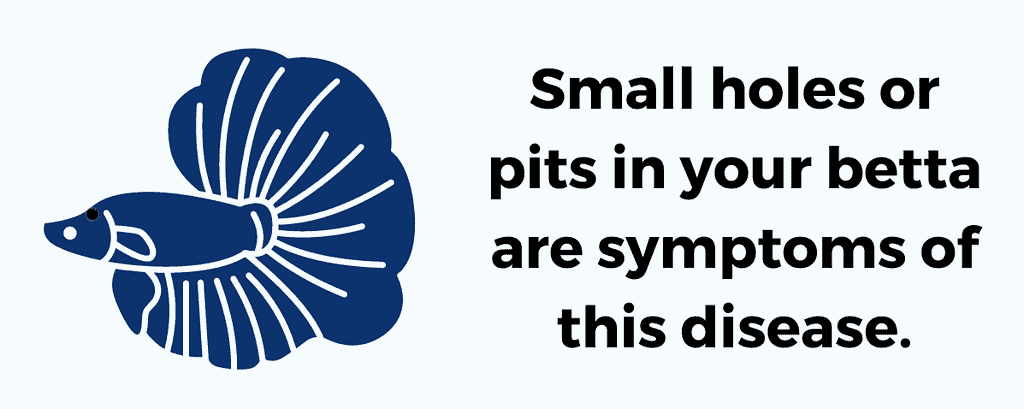
Learning the common symptoms of hole in the head lets you diagnose the disease in its early stages.
Besides the initial signs of the disease, you must pay attention to other symptoms in your betta for a proper diagnosis.
Several obvious symptoms can help you identify hole in the head.
Physical Symptoms
Hole in the head disease has several unique physical symptoms.
These primary symptoms help you distinguish between hole in the head and other illnesses.
Small Holes or Pits in the Head
Small holes or pits in the head and body of your betta are the most obvious symptoms of this disease.
Unfortunately, by the time these lesions develop, your betta’s chance of death is high.
Treatment at this stage of the disease is difficult. Your betta may die within a few days of the holes developing.
The holes and pits usually have a light color to them. This is different from other open wounds, which usually appear red or bloody.
Sometimes, the holes look like white fuzzy spots. This is often confused with ich.
Loss of Color
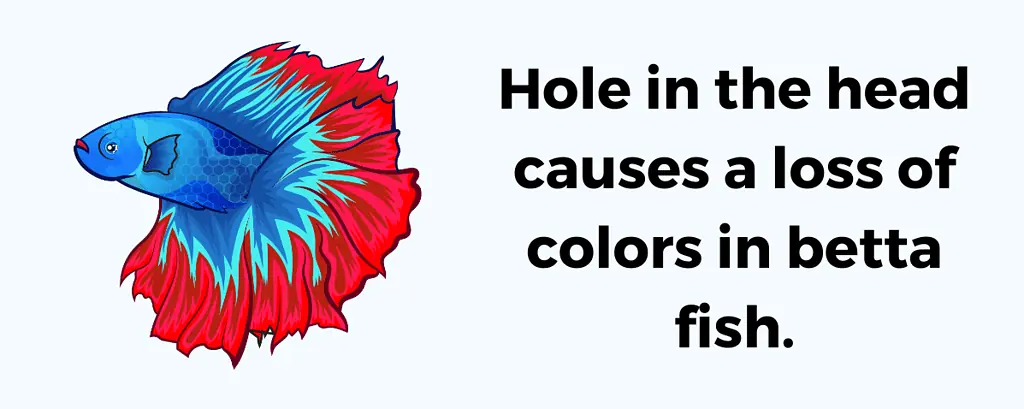
Healthy bettas have brightly colored bodies and fins.
Hole in the head causes a loss of colors in betta fish. This is an early symptom you must watch out for.
But a loss of color is not limited to hole in the head.
Depression, stress, and other illnesses may cause color loss as well.
Stripes sometimes develop on a betta suffering from prolonged stress.
If you notice fading colors in your betta, look for other symptoms of hole in the head for a confirmed diagnosis.
Swelling or Inflammation
Hole in the head disease starts with an infection in a betta’s intestines.
This infection may cause swelling and inflammation, making your betta bloated.
Bloating is also a common symptom of illnesses like constipation, swim bladder disease, and dropsy.
Stringy Feces

When the infection from hole in the head starts attacking your betta’s intestines, you will notice a change in your betta’s feces.
The intestines start producing more mucus. This mucus helps fight the infection.
As the mucus increases, your betta’s feces become white and stringy.
Normal betta poop is small and round with a brown or tan color.
White, stringy feces are an early sign of hole in the head.
If you notice stringy feces coming from your betta, start treatment immediately.
The sooner you start treatment for hole in the head, you increase your betta’s chance of survival.
Behavioral Symptoms
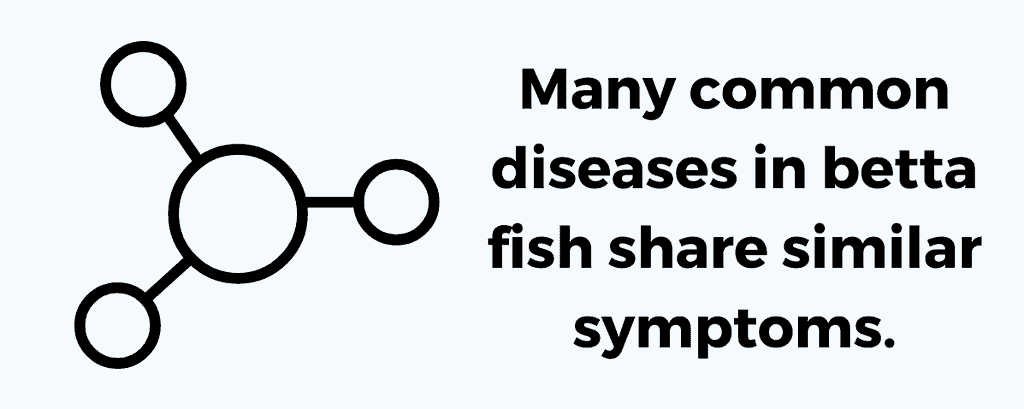
Along with physical symptoms, several behavioral changes are associated with hole in the head.
Behavioral changes are usually vague. These types of symptoms exist with many common diseases in betta fish.
But when these changes happen along with the physical symptoms above, you have a better chance of diagnosing hole in the head disease.
Lethargy
Hole in the head makes your betta weak and lethargic.
Bettas usually swim around their tank exploring the plants and decorations.
A sudden decrease in your betta’s activity levels is a bad sign.
Your betta may often sleep during the day or stay in one of its hiding places.
Loss of Appetite

Loss of appetite is another early sign of hole in the head disease in bettas.
Since the infection starts in the betta’s intestines, the fish does not feel like eating.
Bettas are usually greedy eaters. If your betta starts spitting food out or stops eating, check for other signs of hole in the head disease.
The lack of appetite can lead to nutrient deficiency in betta fish.
Without essential nutrients, your betta’s immune system weakens. This makes it difficult for the fish to fight off infections.
Your betta may also start losing a lot of weight and become emaciated.
Loss of appetite is also a symptom of other common fish diseases like dropsy and swim bladder disease.
Appetite loss combined with stringy feces is a good indicator of hole in the head disease.
Excessive Rubbing Against Objects

If your betta rubs against objects in the tank, this is a sign of parasites.
A parasitic infection is one of the possible causes of hole in the head disease.
Parasites cause itchiness and discomfort in a betta fish.
You may notice your betta rubbing against tank decorations or the glass sides of the aquarium. This is your betta’s attempt at removing the parasites.
This symptom also occurs with ich and columnaris.
Stress also causes this symptom as the betta looks for a hiding place.
Common Causes of Hole in the Head Disease
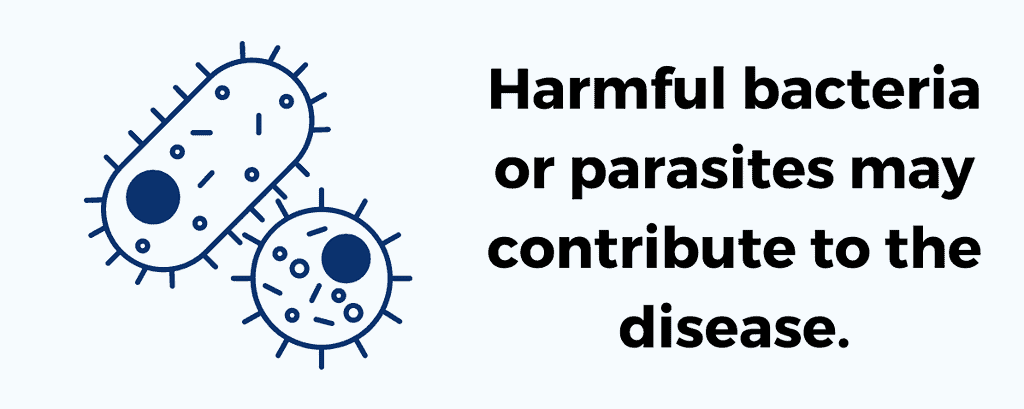
Fish biologists and expert aquarists do not know the exact cause of hole in the head disease.
Hole in the head may occur due to a combination of poor living conditions and harmful bacteria or parasites.
There are several factors you must consider when determining the cause of hole in the head in your betta.
Poor Water Quality
Ideal Water Parameters for a Betta Fish Tank Include the following:
- Temperature: 78-80° degrees Fahrenheit (25.5-27° C)
- pH: 6.5-7.5
- Ammonia and Nitrite: 0 ppm
- Nitrate: < 40 ppm
- gH: 3-4 dGH (50-66.7 ppm)
- kH: 3-5 dKH (53.6-89.4 ppm)
- Minimum Tank Size: 5 Gallons
Poor water quality is the leading cause of stress in betta fish.
Dirty water also contains a variety of toxins and disease-causing parasites.
Any of these issues can make your betta fish sick.
High Levels of Ammonia or Nitrite
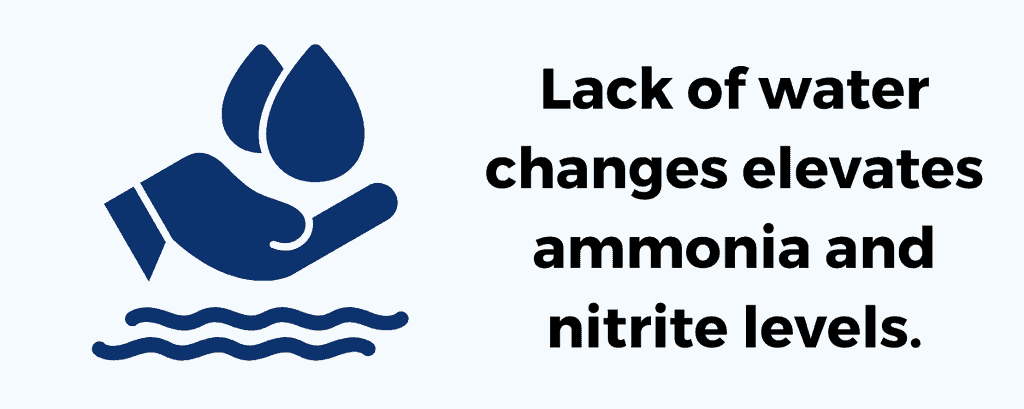
Dead plants, decaying food, and fish feces release ammonia into the tank water.
A lack of water changes creates high levels of ammonia and nitrite.
The buildup of ammonia and nitrite creates a toxic living environment for your betta.
High levels of ammonia and nitrite cause skin conditions and breathing issues. They also make your betta prone to parasite attacks.
Low Levels of Oxygen
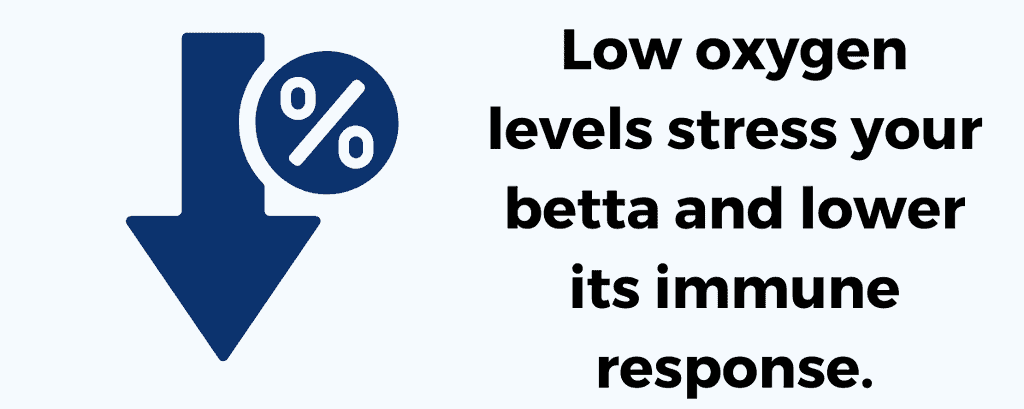
Low oxygen levels in a fish tank stress your betta and lower its immune response.
This makes your betta prone to parasites and bacterial infections causing hole in the head disease.
Overuse of water conditioners or medications can decrease oxygen in the water.
Inadequate oxygen in the water makes the betta swim to the surface for air more often. Your betta might stay at the surface more often in general.
You may also notice more gill movement or gasping from your betta.
Ensure your aquarium filter works correctly and consider installing an air bubbler in the tank.
Air bubblers or air stones increase oxygen levels in the aquarium, making your betta more comfortable.
High Levels of Chlorine or Chloramine
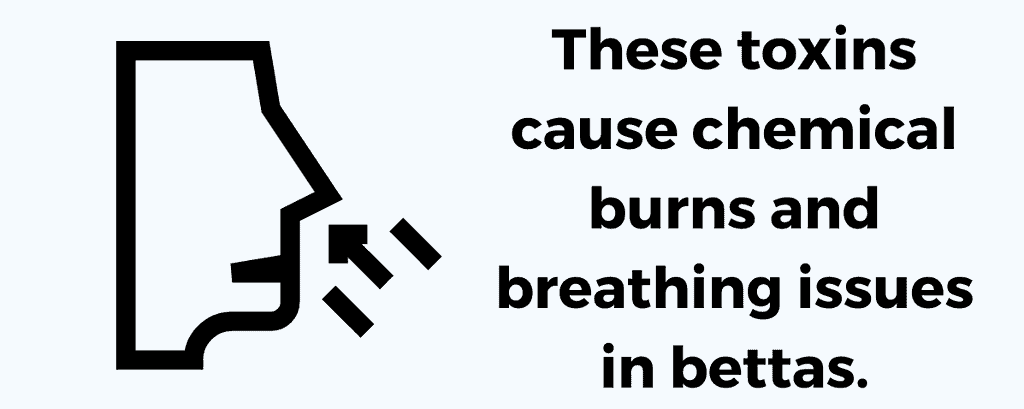
Tap water usually contains chlorine or chloramine. These additives remove harmful bacteria and make the water safe for drinking.
But chlorine and chloramine are extremely toxic for betta fish.
These toxins cause chemical burns and breathing issues in bettas. Lesions or open wounds increase the risk of bacterial infections leading to hole in the head.
Always add a water conditioner to fresh water before adding it to the betta tank. Water conditioners remove chlorine and chloramine, making the water safe for your betta.
Follow the instructions on the label for the correct dosage per gallon of water.
Unstable Water Temperatures and pH

Fluctuations in temperature or pH levels can make your betta stressed.
Sudden temperature changes may even cause temperature shock in bettas.
Maintaining stable water conditions protects your betta from diseases like hole in the head.
Ideal water conditions for bettas include pH levels of 7.0 and temperatures between 78-80° degrees Fahrenheit (25.5-27° C).
Nutritional Deficiencies
A betta’s diet significantly prevents illnesses like hole in the head.
You must ensure your betta receives proper nutrition without overfeeding your fish.
Lack of Essential Vitamins and Minerals
Since bettas are carnivores, they may lack certain plant-based nutrients in their diet.
Vitamins A, C, and E are especially important for immune system health. Minerals like iron and calcium encourage healthy growth.
Look for pellet foods containing these essential nutrients.
Inadequate Protein in the Diet
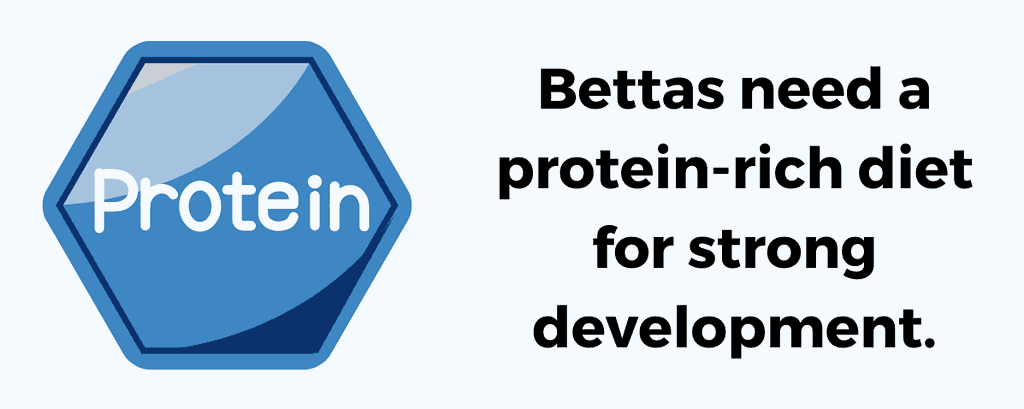
Bettas need a protein-rich diet for strong development and a healthy immune system.
These carnivorous fish cannot survive on a plant-based diet like other tropical fish.
Pellet foods with at least a 35% protein content are a good choice for your betta.
Supplement your betta’s protein needs with live, freeze-dried, or frozen foods.
Be aware of possible parasite contamination in live foods. Always buy live foods like blood worms and mosquito larvae from reputable sources.
Parasites or Bacteria
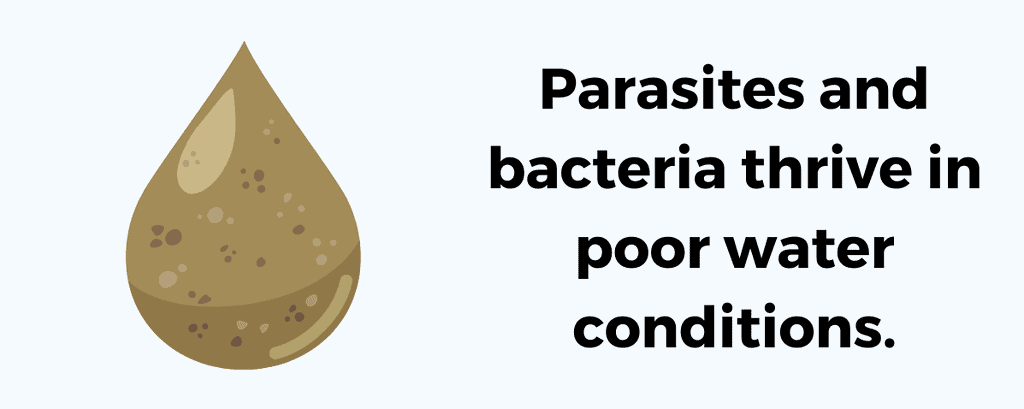
Parasites and bacteria thrive in poor water conditions.
Certain parasites and bacteria are possible causes of hole in the head disease.
Injuries or open wounds also leave your betta prone to secondary infections leading to hole in the head.
Parasitic Infections

A protozoan parasite called Hexamita is the cause of many cases of hole in the head disease.
The Hexamita parasite starts in the intestines of bettas before migrating to the sensory pores on the head.
Low levels of this protozoan parasite can live in a betta’s stomach without causing damage. But if the betta’s immune system weakens, the parasites rapidly multiply.
Once the Hexamita parasites reach the sensory pores, they cause tissue decay. This often leads to secondary infections.
Hexamita parasites are not considered contagious. But they may spread easily to a sick fish with a weakened immune response.
Bacterial Infections

Bacteria known as Aeromonas may cause hole in the head disease in betta fish.
Aeromonas bacteria is highly contagious and can infect several internal organs in a fish.
Dirty water conditions usually cause bacteria. A poor diet makes a betta more prone to infection from Aeromonas.
Symptoms of Aeromonas in bettas include ulcers on the head and body and ragged fins.
Fluid accumulation in a betta’s body due to Aeromonas may cause renal failure and protruding eyes.
Aeromonas quickly leads to death without prompt treatment with strong antibiotic medicine.
Aggressive Tank Mates
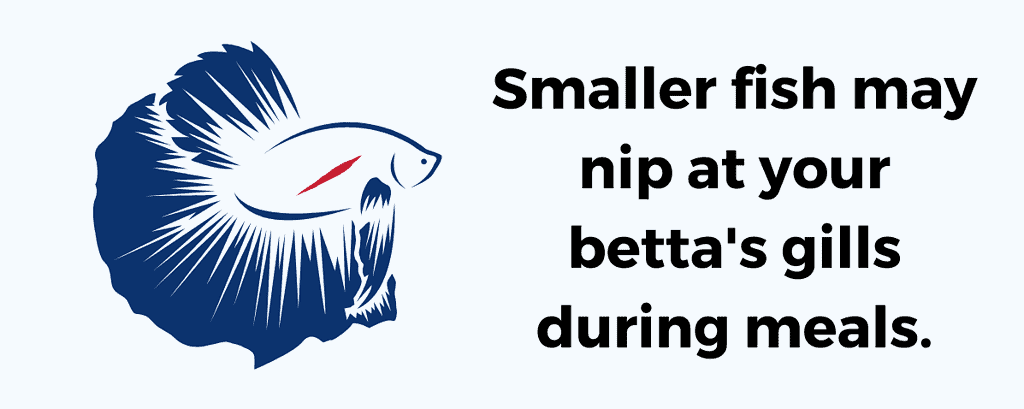
Many fish keepers set up a community tank for their betta.
Bettas are known for attacking other fish. But bettas are also prone to attacks from other aggressive fish species.
Smaller fish may nip at your betta’s gills during meal times. They may also attack a betta’s long fins or cause open wounds on the body.
These constant attacks cause a lot of stress in your betta. Stress combined with physical injuries leaves your betta prone to bacterial and parasitic diseases like hole in the head.
Whenever you see aggression in your community tank, immediately remove the fish to a separate tank.
Prevention and Treatment of Hole in the Head Disease
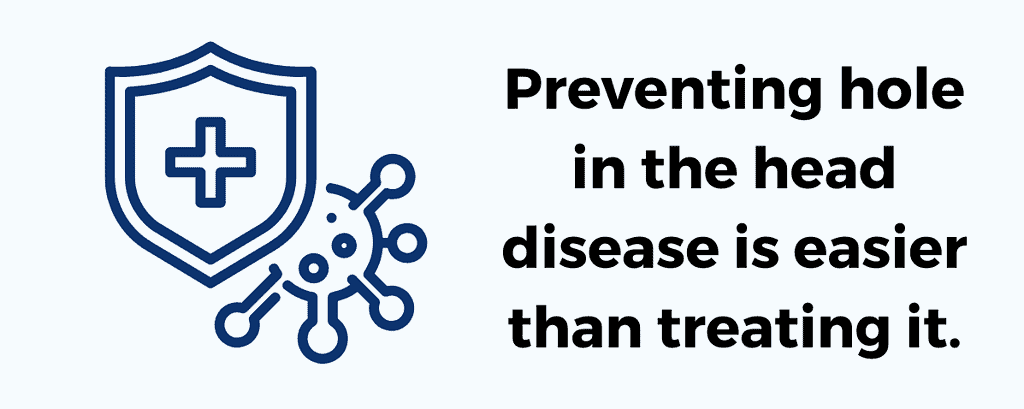
Preventing hole in the head disease is much easier than treating it.
Your betta can stay healthy enough to avoid the disease with proper tank maintenance and fish care.
If your betta does contract hole in the head disease, prompt treatment is crucial.
Water Quality and Maintenance
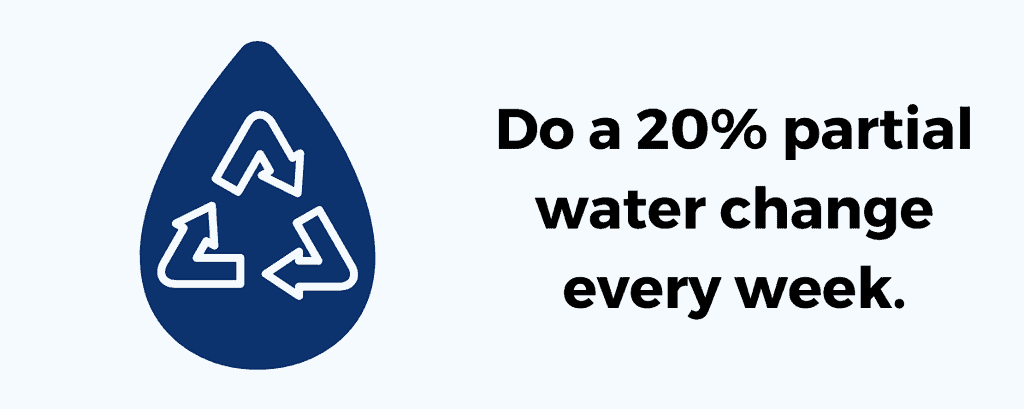
Keep your tank water clean with frequent water changes.
Incorrect water chemistry results from decaying plant matter, leftover food, and fish waste.
Do a 20% partial water change every week. Removing more water than this from the tank may result in an imbalance of beneficial bacteria.
When performing the water change, use the gravel vacuum to clean debris from the substrate.
Use an algae scraper to clean algae off of the tank glass.
A clean aquarium benefits your betta fish. Cleaner water contains fewer parasites and harmful bacteria.
Provide a safe environment for your betta by establishing a regular tank maintenance routine.
Diet and Nutrition
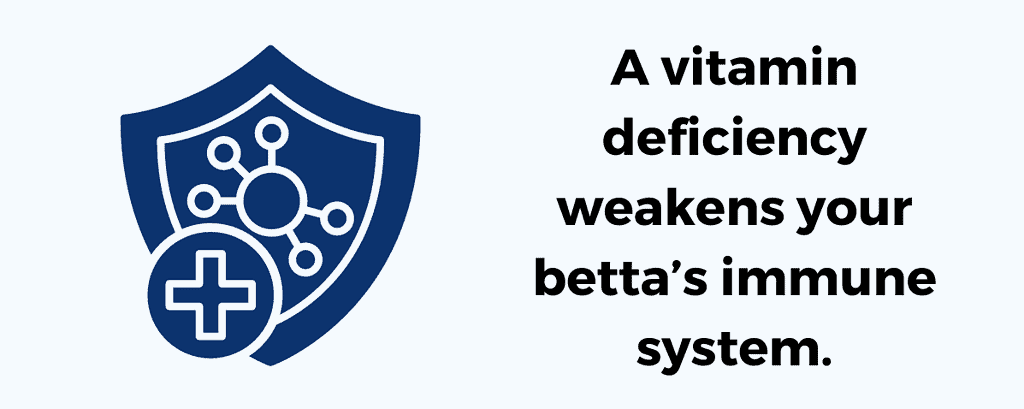
Always feed your betta a high-quality, balanced diet. A vitamin deficiency weakens your betta’s immune system.
Ensure your betta’s pellet foods contain plenty of essential protein, vitamins, and minerals.
Provide a varied diet with live, freeze-dried, or frozen foods. Avoid potential parasites by getting live foods from a reputable source.
Some nutritious food options include:
- Brine shrimp
- Mosquito larvae
- Daphnia
- Blood worms
Fast your betta for one day every week. Fasting improves digestion and prevents constipation.
Check out our guide to betta fish diet for more details.
Avoid Overcrowding in a Community Tank
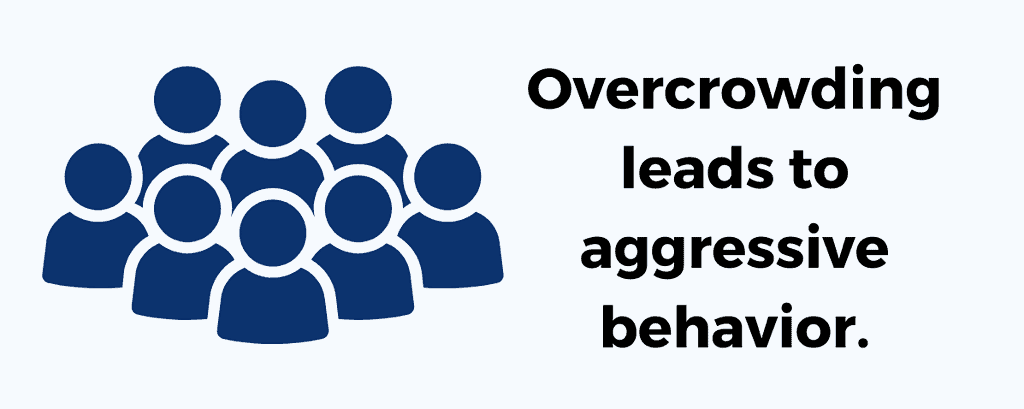
Never keep too many fish in a community tank with your betta.
Overcrowding leads to aggressive behavior and creates poor water conditions.
I recommend at least a 10-gallon tank for housing your betta with tank mates like snails and shrimp.
A 20-gallon tank is better for adding schooling fish like neon tetras and rasboras to your betta tank.
Medications and Treatments
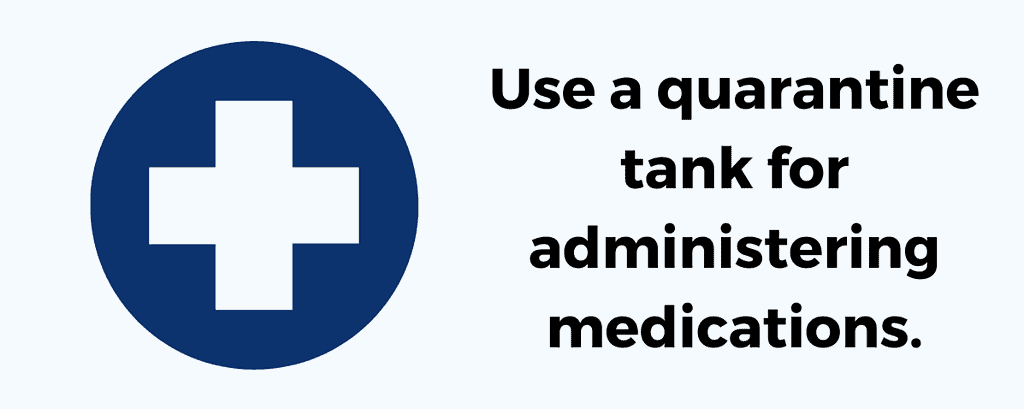
Medicines like dimetridazole and metronidazole are effective in treating hole in the head disease.
You may add the medicine to the food. If your betta is not eating, you must treat the water.
Use a separate quarantine tank for administering medications to your betta. The quarantine tank prevents your live plants from becoming damaged by the medicine.
Following proper quarantine protocols also protects healthy fish from contagious diseases.
When treating your betta with medicine for hole in the head, follow the recommended dosage levels provided by your veterinarian.
Saving Your Betta From Hole in the Head Disease
Hole in the head disease starts as an intestinal infection before it causes deep pits and holes in a betta’s head.
Diagnosing the disease in its early stages is crucial for your betta’s survival.
Begin treatment at the first signs of intestinal symptoms like stringy feces and loss of appetite.
Starting treatment after the lesions appear on the head decreases your betta’s chance of fully recovering.
Prevent hole in the head disease by keeping your betta’s environment clean and providing a nutritious diet.
For more on typical betta diseases, check out our massive guide at the link.


